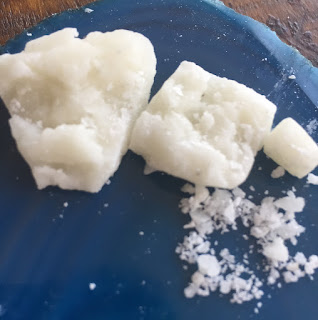To us sociology students, it is no secret that the
United States of America has the largest inmate population. It is unmatched across the world. America hold 5% of the world population, but
the also house 25% of the worlds criminals.
Robert J. Sampson states that from the 1920’s to the 1970s the inmate
population averaged 110 inmates per 100,000 persons. Across this time frame, it matched other
nation’s incarceration rates. From 1970
until present time, the incarceration rate has exploded. Sampson states that in 1990 the rate jumped
to 197 inmates per 100,000 persons, and in 2008 the figure skyrocketed to 504
inmates per 100,000. These current
figures greatly impact disadvantaged youth in urban areas. Incarceration has almost been normalized in
the lives of the aforementioned disadvantaged people.

Above: an info-graphic depicting America's incarceration rate vs. other countries
Right: two grams of crack-cocaine
There are a few outstanding reasons as to why these
numbers have reached unprecedented rates.
In the late 1970s, legislation was created to target urban areas. This legislation sparked a war that the
government still pursues today: The War on Drugs. Crack-cocaine was created and found its way
into poorer urban areas giving way to dealers and users. Crack was cheaper than traditional powder
cocaine, but because of its potency and necessary human adulteration, the drug
landed in the schedule II category. The
Anti-Drug Abuse Act of 1986 increased penalties for crack cocaine possession
and usage. It mandated a mandatory
minimum sentence of five years without parole for possession of five grams of
crack. If a person was caught with 500
grams of cocaine, they would receive the same sentence. Individuals of color are more likely to use
crack, and richer, more affluent people are more likely to use cocaine. The legislation in place unfairly targets
those who are poorer and more susceptible for crack usage. Those who are poorer and caught with
crack-cocaine are less likely to afford legal representation. Crack has contributed to the mass
incarceration of those of color and of lower class.
Housing segregation has given rise to poor urban
areas, allowing drug use and gang violence to explode. We learned in class that often times the
southern part of urban areas are impoverished, for reasons unknown. As the housing boom in the late 1960s
erupted, segregation was still deeply engrained in American society. Neighborhoods did not want colored families
living with them. Sampson mentions a “tangle
of pathology”, also known as social dislocation. The tangle of pathology is amplified, more
durable, and qualitatively distinct in the black community. Sampson uses Chicago as an example of an
urban area which displays intensely segregated urban structure. We have learned from William Julius Wilson
that the “Ghetto” is persistent in these highly segregated, mostly colored,
urban areas. Individuals in these areas
have extremely limited upward mobility, jobs are scarce, and gang behavior and drug
usage is common.
Everything placed in
legislature regarding drugs and urban behavior has been tailored and executed
in order to mass incarcerate those who are of lower class. We know that the prison system in America is
flawed, yet it seems that things are only progressively getting worse. A major change needs to happen especially to
those who are convicted of non-violent drug offenses. It costs tons of money to place people into
the prison system, with countless dollars spent on policing and drug
enforcement every year.
A brief history of the crack epidemic: http://www.drugfreeworld.org/drugfacts/crackcocaine/a-short-history.html
Chicago housing segregation: http://www.chicagotribune.com/news/ct-segregation-declines-neighborhoods-change-met-20160103-story.html

Overall, this was a very well written blog. It was very straight forward and to the point. Something that stuck out to me right away were the facts and statistics that were presented to the ready in the very first paragraph. These are very compelling facts that for really got my attention and made me want to keep reading. As a side note to these statistics, they reminded me of a clip form the “Newsroom”. College students are asking these smart influential people, “Why America is the greatest country in the World?” When the question gets to Jeff Daniels he expresses how he does not feel this country is the greatest, he states how there are only (2) things that America is leading the rest of the world in, that is number of Americans incarcerated, and number of adults who still believe in angels. Getting back to the blog, this is shows how America claims were the greatest country in the world yet the facts and statistics would argue otherwise. Moving on, I really liked how you explained the demographics of who really uses and sells which drug. The people that are buying crack, versus the people that are buying cocaine are very different, so this is an important fact to mention. It isn’t those who are buying and using cocaine who are suffering from this strict enforcement on drugs or the war on drugs. It’s the poorer, lower class individuals. This fact also presents itself in our prison population, because the lower class individuals are the ones present in prisons, not the wealthy upper class persons.
ReplyDelete